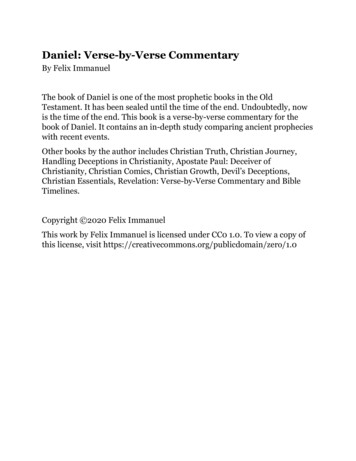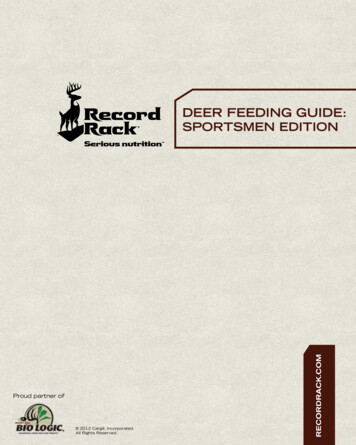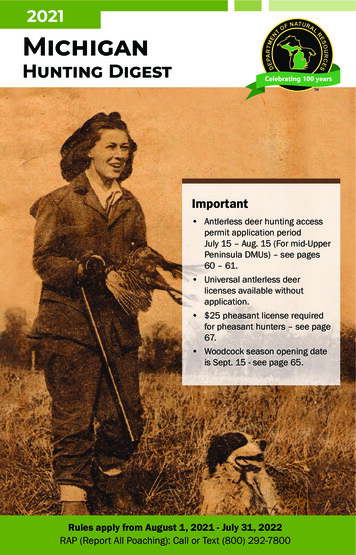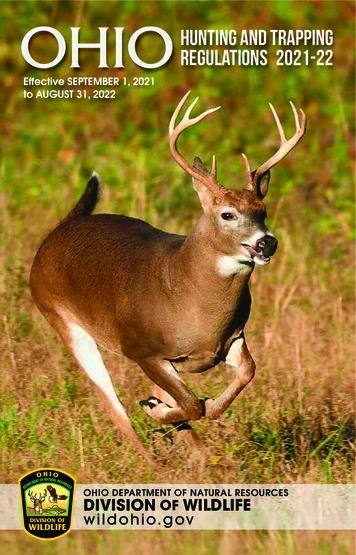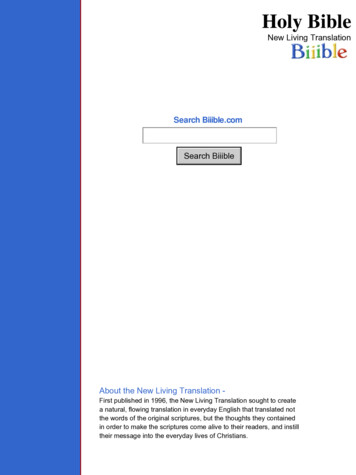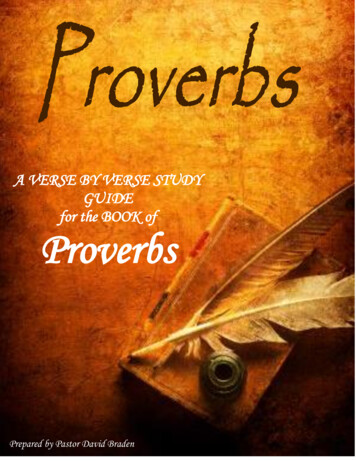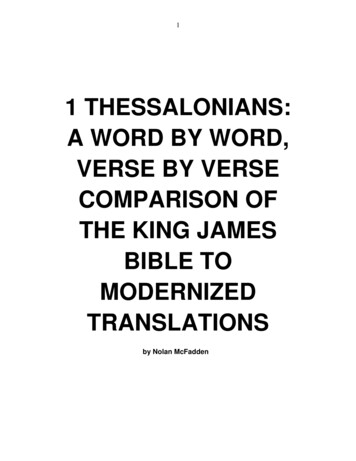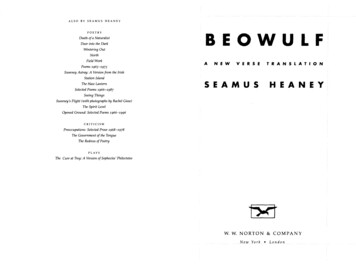
Transcription
ALSOBY S E A M U SHEANEYPOETRY Death of a NaturalistI SE Door into the DarkWintering OutNorth%JE \ » J k #II W\ LW EIField WorkAN E W V E R S ET R A N S L A T I O NPoems 1965-1975Sweeney Astray: A Version from the IrishStation IslandThe Haw LanternSelected Poems 1966-1987SEAMUSHEASeeing ThingsSweeney's Flight (with photographs by Rachel Giese)The Spirit LevelOpened Ground: Selected Poems 1966-1996CRITICISMPreoccupations: Selected Prose 1968-1978The Government of the TongueThe Redress of PoetryPLAYSThe Cure at Troy: A Version of Sophocles' PhiloctetesW. W. NORTON & COMPANYNewYork LondonNEY
Copyright 2000 by Seamus HeaneyAll rights reservedPrinted in the United States of AmericaDesigned by Cynthia KrupatFirst bilingual edition 2000 published by arrangement with Farrar, Straus and GirouxFirst published as a Norton paperback 2001Library of Congress Cataloging-in-Publication DataBeowulf. English & English (Old English)Beowulf I [translated by] Seamus Heaney. — 1st ed.p. cm.Text in English and Old English.1. Heroes—Scandinavia—Poetry. 2. Epic poetry, English (Old).3. Monsters—Poetry. 4. Dragons—Poetry. I. Heaney, Seamus.PE1383.H43 1999829 .3—dC2iISBN 0-393-32097-9 pbk.99-23209W. W. Norton ir Company, Inc.500 Fifth Avenue, New York, N.Y. 10110www.wwnorton.comW. W. Norton ir Company Ltd.Castle House, 75/76 Wells Street, London W1T3QT0The Old English text of the poem is based on Beowulf, with theFinnesburg Fragment, edited by C. L. Wrenn and W. F. Bolton(University of Exeter Press, 1988), and is printed here by kindpermission ofW. F. Bolton and the University of Exeter Press. memQryu0fJTedHugkeS
ContentsIntroductionpage ixA Note on Names by Alfredpage xxxiBEOWULFpage 2Family Treespage 217Acknowledgementspage 219David
IntroductionAnd now this is 'an inheritance'—Upright, rudimentary, unshiftably plankedIn the long ago, yet willable forwardAgain and again and again.B E O W U L F : THEPOEMThe poem called Beowulf was composed sometime between themiddle of the seventh and the end of the tenth century of the firstmillennium, in the language that is to-day called Anglo-Saxon orOld English. It is a heroic narrative, more than three thousandlines long, concerning the deeds of a Scandinavian prince, alsocalled Beowulf, and it stands as one of the foundation works ofpoetry in English. The fact that the English language has changedso much in the last thousand years means, however, that thepoem is now generally read in translation and mostly in Englishcourses at schools and universities. This has contributed to theimpression that it was written (as Osip Mandelstam said of TheDivine Comedy) "on official paper," which is unfortunate, sincewhat we are dealing with is a work of the greatest imaginativevitality, a masterpiece where the structuring of the tale is as elaborate as the beautiful contrivances of its language. Its narrativeelements may belong to a previous age but as a work of art itlives in its own continuous present, equal to our knowledge ofreality in the present time.The poem was written in England but the events it describesare set in Scandinavia, in a "once upon a time" that is partly historical. Its hero, Beowulf, is the biggest presence among the warriors in the land of the Geats, a territory situated in what is nowsouthern Sweden, and early in the poem Beowulf crosses the seato the land of the Danes in order to clear their country of a man-
xeating monster called Grendel. From this expedition (which involves him in a second contest with Grendel's mother) he returnsin triumph and eventually rules for fifty years as king of hishomeland. Then a dragon begins to terrorize the countryside andBeowulf must confront it. In a final climactic encounter, he doesmanage to slay the dragon, but he also meets his own death andenters the legends of his people as a warrior of high renown.We know about the poem more or less by chance because it exists in one manuscript only. This unique copy (now in the BritishLibrary) barely survived a fire in the eighteenth century and wasthen transcribed and titled, retranscribed and edited, translatedand adapted, interpreted and reinterpreted, until it has becomecanonical. For decades it has been a set book on English syllabuses at university level all over the world. The fact that manyEnglish departments require it to be studied in the original continues to generate resistance, most notably at Oxford University,where the pros and cons of the inclusion of part of it as a compulsory element in the English course have been debated regularly in recent years.extent (if at all) the newly Christian understanding of the worldwhich operates in the poet's designing mind displaces him fromhis imaginative at-homeness in the world of his poem—a paganGermanic society governed by a heroic code of honour, onewhere the attainment of a name for warrior-prowess among theliving overwhelms any concern about the soul's destiny in theafterlife.However, when it comes to considering Beowulf as a work ofliterature, there is one publication that stands out. In 1936, theOxford scholar and teacher J.R.R. Tolkien published an epochmaking paper entitled "Beowulf: The Monsters and the Critics"which took for granted the poem's integrity and distinction as awork of art and proceeded to show in what this integrity and distinction inhered. He assumed that the poet had felt his waythrough the inherited material—the fabulous elements and thetraditional accounts of an heroic past—and by a combination ofcreative intuition and conscious structuring had arrived at aunity of effect and a balanced order. He assumed, in other words,that the Beowulf poet was an imaginative writer rather than someFor generations of undergraduates, academic study of thepoem was often just a matter of construing the meaning, gettinga grip on the grammar and vocabulary of Anglo-Saxon, and being able to recognize, translate, and comment upon random extracts which were presented in the examinations. For generationsof scholars too the interest had been textual and philological;then there developed a body of research into analogues andsources, a quest for stories and episodes in the folklore and legends of the Nordic peoples which would parallel or foreshadowepisodes in Beowulf Scholars were also preoccupied with fixingthe exact time and place of the poem's composition, payingminute attention to linguistic, stylistic, and scribal details. Moregenerally, they tried to establish the history and genealogy of thedynasties of Swedes and Geats and Danes to which the poetmakes constant allusion; and they devoted themselves to a consideration of the world-view behind the poem, asking to whatkind of back-formation derived from nineteenth-century folkloreand philology. Tolkien's brilliant literary treatment changed theway the poem was valued and initiated a new era—and newterms—of appreciation.It is impossible to attain a full understanding and estimate ofBeowulf without recourse to this immense body of commentaryand elucidation. Nevertheless, readers coming to the poem forthe first time are likely to be as delighted as they are discomfitedby the strangeness of the names and the immediate lack ofknown reference points. An English speaker new to The Iliad orThe Odyssey or The Aeneid will probably at least have heard ofTroy and Helen, or of Penelope and the Cyclops, or of Dido andthe golden bough. These epics may be in Greek and Latin, yet theclassical heritage has entered the cultural memory enshrined inEnglish so thoroughly that their worlds are more familiar thanthat of the first native epic, even though it was composed cen-IIntroductionIntroduction\xi
turies after them. Achilles rings a bell, but not Scyld Scefing.Ithaca leads the mind in a certain direction, but not Heorot. TheSibyl of Cumae will stir certain associations, but not bad QueenModthryth. First-time readers of Beowulf very quickly rediscoverthe meaning of the term "the dark ages," and it is in the hope ofdispelling some of the puzzlement they are bound to feel that Ihave added the marginal glosses which appear in the followingpages.Still, in spite of the sensation of being caught between a"shield-wall" of opaque references and a "word-hoard" that isold and strange, such readers are also bound to feel a certain"shock of the new." This is because the poem possesses a mythicpotency. Like Shield Sheafson (as Scyld Scefing is known in thistranslation), it arrives from somewhere beyond the knownbourne of our experience, and having fulfilled its purpose (againlike Shield), it passes once more into the beyond. In the intervening time, the poet conjures up a work as remote as Shield's funeral boat borne towards the horizon, as commanding as thehorn-pronged gables of King Hrothgar's hall, as solid and dazzling as Beowulf's funeral pyre that is set ablaze at the end.These opening and closing scenes retain a haunting presence inthe mind; they are set pieces but they have the life-markingpower of certain dreams. They are like the pillars of the gate ofhorn, through which wise dreams of true art can still be said topass.What happens in between is what William Butler Yeats wouldhave called a phantasmagoria. Three agons, three struggles inwhich the preternatural force-for-evil of the hero's enemiescomes springing at him in demonic shapes. Three encounterswith what the critical literature and the textbook glossaries call"the monsters." In three archetypal sites of fear: the barricadednight-house, the infested underwater current, and the reptilehaunted rocks of a wilderness. If we think of the poem in thisway, its place in world art becomes clearer and more secure. Wecan conceive of it re-presented and transformed in performanceiiIIntroductionin a bunraku theatre in Japan, where the puppetry and the poetryare mutually supportive, a mixture of technicolour spectacle andritual chant. Or we can equally envisage it as an animated cartoon (and there has been at least one shot at this already), full ofmutating graphics and minatory stereophonies. We can avoid, atany rate, the slightly cardboard effect which the word "monster"tends to introduce, and give the poem a fresh chance to sweep"in off the moors, down through the mist bands" of Anglo-SaxonEngland, forward into the global village of the third millennium,Nevertheless, the dream element and overall power to hauntcome at a certain readerly price. The poem abounds in passageswhich will leave an unprepared audience bewildered. Just whenthe narrative seems ready to take another step ahead into themain Beowulf story, it sidesteps. For a moment it is as if we havebeen channel-surfed into another poem, and at two points in thistranslation I indicate that we are in fact participating in a poemwithin-our-poem not only by the use of italics but by a slightquickening of pace and shortening of metrical rein. The passagesoccur in lines 883-914 and lines 1070-1158, and on each occasiona minstrel has begun to chant a poem as part of the celebrationof Beowulf's achievement. In the former case, the minstrel expresses his praise by telling the story of Sigemund's victory overa dragon, which both parallels Beowulf's triumph over Grendeland prefigures his fatal encounter with the wyrm in his old age.In the latter—the most famous of what were once called the "digressions" in the poem, the one dealing with a fight betweenDanes and Frisians at the stronghold of Finn, the Frisian king—the song the minstrel sings has a less obvious bearing on the immediate situation of the hero, but its import is neverthelesscentral to both the historical and the imaginative world of thepoem.The "Finnsburg episode" envelops us in a society that is atonce honour-bound and blood-stained, presided over by thelaws of the blood-feud, where the kin of a person slain are boundto exact a price for the death, either by slaying the killer or by re-Introduction\xiii
'vceiving satisfaction in the form of wergild (the "man-price"), alegally fixed compensation. The claustrophobic and doom-ladenatmosphere of this interlude gives the reader an intense intimation of what wyrd, or fate, meant not only to the characters in theFinn story but to those participating in the main action of Beowulfitself. All conceive of themselves as hooped within the greatwheel of necessity, in thrall to a code of loyalty and bravery,bound to seek glory in the eye of the warrior world. The little nations are grouped around their lord, the greater nations spoil forwar and menace the little ones, a lord dies, defencelessness ensues, the enemy strikes, vengeance for the dead becomes an ethicfor the living, bloodshed begets further bloodshed, the wheelturns, the generations tread and tread and tread. Which is what Imeant above when I said that the import of the Finnsburg passage is central to the historical and imaginative world of thepoem as a whole.hall of his "ring-giver," Hygelac, lord of the Geats, the hero discourses about his adventures in a securely fortified cliff-top enclosure. But this security is only temporary, for it is the destinyof the Geat people to be left lordless in the end. Hygelac's alliances eventually involve him in deadly war with the Swedishking, Ongentheow, and even though he does not personallydeliver the fatal stroke (two of his thanes are responsible forthis—see 11. 2484-89 and then the lengthier reprise of this modent at II. 2922-3003), he is known in the poem as "Ongentheow's killer." Hence it comes to pass that after the death ofBeowulf, who eventually succeeds Hygelac, the Geats experiencea great foreboding and the epic closes in a mood of sombre expectation. A world is passing away, the Swedes and others aremassing on the borders to attack, and there is no lord or hero torally the defence,The Swedes, therefore, are the third nation whose history andOne way of reading Beowulf is to think of it as three agons inthe hero's life, but another way would be to regard it as a poemwhich contemplates the destinies of three peoples by tracingtheir interweaving histories in the story of the central character.First we meet the Danes—variously known as the Shieldings (after Shield Sheafson, the founder of their line), the Ingwins, theSpear-Danes, the Bright-Danes, the West-Danes, and so on—apeople in the full summer of their power, symbolized by the highhall built by King Hrothgar, one "meant to be a wonder of theworld." The threat to this gilded order comes from within, frommarshes beyond the pale, from the bottom of the haunted merewhere "Cain's clan," in the shape of Grendel and his troll-dam,trawl and scavenge and bide their time. But it also comes fromwithout, from the Heathobards, for example, whom the Daneshave defeated in battle and from whom they can therefore expectretaliatory war (see 11. 2020-69).destiny are woven into the narrative, and even though no partof the main action is set in their territory, they and their kingsconstantly stalk the horizon of dread within which the main protagonists pursue their conflicts and allegiances. The Swedish dimension gradually becomes an important element in the poem'semotional and imaginative geography, a geography which entails, it should be said, no very clear map-sense of the world,more an apprehension of menaced borders, of danger gatheringbeyond the mere and the marshes, of mearc-stapas "prowling themoors, huge marauders / from some other world."Within these phantasmal boundaries, each lord's hall is an actual and a symbolic refuge. Here is heat and light, rank and ceremony, human solidarity and culture; the dugud share themead-benches with the geogod, the veterans with their tales ofwarrior kings and hero-saviours from the past rub shoulderswith young braves—pegnas, eorlas, thanes, retainers—keen toBeowulf actually predicts this turn of events when he goesback to his own country after saving the Danes (for the time being, at any rate) by staving off the two "reavers from hell." In thewin such renown in the future. The prospect of gaining a glorious name in the wael-raes, in the rush of battle-slaughter, thepride of defending one's lord and bearing heroic witness to theIIntroductionIntroduction xv
integrity of the bond between him and his hall-companions—abond sealed in the gleo and gidd of peace-time feasting and ringgiving—this is what gave drive and sanction to the Germanicwarrior-culture enshrined in Beowulf.Heorot and Hygelac's hall are the hubs of this value systemupon which the poem's action turns. But there is another, outerrim of value, a circumference of understanding within which theheroic world is occasionally viewed as from a distance and recognized for what it is, an earlier state of consciousness and oilture, one which has not been altogether shed but which has nowbeen comprehended as part of another pattern. And this circumference and pattern arise, of course, from the poet's Christianityand from his perspective as an Englishman looking back atplaces and legends which his ancestors knew before they madetheir migration from continental Europe to their new home onthe island of the Britons. As a consequence of his doctrinal certitude, which is as composed as it is ardent, the poet can view thestory-time of his poem with a certain historical detachment andeven censure the ways of those who lived in Mo tempore:Sometimes at pagan shrines they vowedofferings to idols, swore oathsthat the killer of souls might come to their aidand save the people. That was their way,their heathenish hope; deep in their heartsthey remembered hell. (II. 175-80)At the same time, as a result of his inherited vernacular cultureand the imaginative sympathy which distinguishes him as anartist, the poet can lend the full weight of his rhetorical power toBeowulf as he utters the first principles of the northern warrior'shonour-code:It is always betterto avenge dear ones than to indulge in mourning.viI IntroductionFor every one of us, living in this worldmeans waiting for our end. Let whoever canwin glory before death. When a warrior is gone,that will he his best and only bulwark. (II. 1384-89)In an age when "the instability of the human subject" is constantly argued for if not presumed, there should be no problemwith a poem which is woven from two such different psychicfabrics. In fact, Beowulf perfectly answers the early modern conception of a work of creative imagination as one in which conflicting realities find accommodation within a new order; andthis reconciliation occurs, it seems to me, most poignantly andmost profoundly in the poem's third section, once the dragon enters the picture and the hero in old age must gather his powersfor the final climactic ordeal. From the moment Beowulf advances under the crags, into the comfortless arena bounded bythe rock-wall, the reader knows he is one of those "marked byfate." The poetry is imbued with a strong intuition of wyrd hovering close, "unknowable but certain," and yet, because it isimagined within a consciousness which has learned to expectthat the soul will find an ultimate home "among the steadfastones," this primal human emotion has been transmuted intosomething less "zero at the bone," more metaphysically tempered.A similar transposition from a plane of regard which is, as itwere, helmeted and hall-bound to one which sees things in aslightly more heavenly light is discernible in the different waysthe poet imagines gold. Gold is a constant element, gleamingsolidly in underground vaults, on the breasts of queens or thearms and regalia of warriors on the mead-benches. It is loadedinto boats as spoil, handed out in bent bars as hall gifts, buried inthe earth as treasure, persisting underground as an affirmation ofa people's glorious past and an elegy for it. It pervades the ethosof the poem the way sex pervades consumer culture. And yet thebullion with which Waels's son, Sigemund, weighs down theIntroduction\xvii
hold after an earlier dragon-slaying triumph (in the old days,long before Beowulf's time) is a more trustworthy substance thanthat which is secured behind the walls of Beowulf's barrow. Bythe end of the poem, gold has suffered a radiation from theChristian vision. It is not that it yet equals riches in the medievalsense of worldly corruption, just that its status as the ore of allvalue has been put in doubt. It is lsene, transitory, passing fromhand to hand, and its changed status is registered as a symptomof the changed world. Once the dragon is disturbed, the melancholy and sense of displacement which pervade the last movement of the poem enter the hoard as a disabling and ominouslight. And the dragon himself, as a genius of the older order, isbathed in this light, so that even as he begins to stir, the readerhas a premonition that the days of his empery are numbered.Nevertheless, the dragon has a wonderful inevitability abouthim and a unique glamour. It is not that the other monsters arelacking in presence and aura; it is more that they remain, for allthe s e a around cliffs," utterly a manifestation of the Germanicheroic code.Enter then, fifty years later, the dragon. From his dry-stonevault from a nest where he is heaped in coils around the bodyheated gold. Once he is wakened, there is something glorious inthe way he manifests himself, a Fourth of July effulgence fireworking its path across the night sky; and yet, because of thecenturies he has spent dormant in the tumulus, there is a foundedness as well as a lambency about him. He is at once a stratumofthe earth and a streamer in the air, no painted dragon but a figureof real oneiric power, one that can easily survive the prejudicewhich arises at the very mention of the word "dragon."Whether in medieval art or in modern Disney cartoons, thedragon can strike us as far less horrific than he is meant to be, butinthe final movement of Beowulf, he lodges himself in the imagination as wyrd rather than wyrm, more a destiny than a set of reptilian vertebrae.their power to terrorize, creatures of the physical world. Grendelcomes alive in the reader's imagination as a kind of dog-breathin the dark, a fear of collision with some hard-boned and immensely strong android frame, a mixture of Caliban and hoplite.And while his mother too has a definite brute-bearing about her,a creature of slouch and lunge on land if seal-swift in the water,she nevertheless retains a certain non-strangeness. As antagonists of a hero being tested, Grendel and his mother possess anappropriate head-on strength. The poet may need them asures who do the devil's work, but the poem needs them more asfigures who call up and show off Beowulf's physical might andhis superb gifts as a warrior. They are the right enemies for aGrendel and his mother enter Beowulf's life from the outside,accidentally, challenges which in other circumstances he mightnothave taken up, enemies from whom he might have been distracted or deflected. The dragon, on the other hand, is a given ofhis home ground, abiding in his underearth as in his understandin& waiting for the meeting, the watcher at the ford, the questioner who sits so sly, the "lion-limb," as Gerard Manley Hopkinsmight have called him, against whom Beowulf's body and soulmu s t measure themselves. Dragon equals shadow-line, thepsalmist's valley of the shadow of death, the embodiment of aknowledge deeply ingrained in the species which is the veryknowledge of the price to be paid for physical and spiritual sur-young glory-hunter, instigators of the formal boast, worthytrophies to be carried back from the grim testing-ground—Grendel's arm is ripped off and nailed up, his head severed andparaded in Heorot. It is all consonant with the surge of youthand the compulsion to win fame "as wide as the wind's home, /xviii Introductionasfig-vival.Irhas often been observed that all the scriptural references inBeowulf are to the Old Testament. The poet is more in sympathywith the tragic, waiting, unredeemed phase of things than withany transcendental promise. Beowulf's mood as he gets ready toIntroduction xix
The wisdomfight the d r a g o n - w h o could be read as a projection of Beowulf'sown chthonic wisdom refined in the crucible of experience-recalls the mood of other tragic heroes: Oedipus at Colonus, Lear athis "ripeness is all" extremity, Hamlet in the last illuminations ofhis "prophetic soul":Mornin8unsettled yet ready, sensing his death.His fate hovered near, unknowable but certain. (II. 2415-21)is worthlesshasin livinon untilrS bornin the Ml8toZ'he wakes8one;he has n0fithat his cMd„ „„„,, u. no easy bargainwould be made in that place by any man.The veteran king sat down on the cliff-top.He wished good luck to the Geats who had sharedhis hearth and his gold. He was sad at heart, fa8ea er morninanother"himto'rememberinterestheir 'Alone with his longing, he lies down on his bed 6and sin s a lament;2 ything seems too large,the steadings and the fields.SuchP a s s a § e s m a r k a n u l t i m a t e s t a S e i n P o e t i c attainment; they aginative equivalent of Beowulf's spiritual state at theare theend' w h e n h e t e l l s h i s m e n t h a t " d o o m o f b a t t l e w i l 1 b e a r [theirly ' " i n the s a m e w a t h a t t h e a-journeys so vividly de-lord awascribed in lines 210-28 and 1903-24 are the equivalent of his exHere the poet attains a level of insight that approaches the visionary. The subjective and the inevitable are in perfect balance, whatis solidly established is bathed in an element which is completelysixth-sensed, and indeed the whole slow-motion, constantly selfdeferring approach to the hero's death and funeral continues tobe like this. Beowulf's soul may not yet have fled "to its destinedplace among the steadfast ones," but there is already a beyond,1. . 1.,. , . 1 ., ,the-grave aspect to him, a revenant quality about his resoluteness.This is not just metrical narrative full of anthropological interestand typical heroic-age motifs; it is poetry of a high order, in whichpassages of great lyric intensity-such as the "Lay of the Last Survivor" (11. 2247- 6) and, even more remarkably, the so-called "Father's Lament" (11. 2 4 4 4 2 ) - r i s e like emanations from somefissure in the bedrock of the human capacity to endure:KX"e'A t these m o m e n t s of lY intensity, the keel of the poetry isP*y n w h i l e t h e mind's l o o k u tswa sy metrically and far-sightedly in the element of pure cornprehension. Which is to say that the elevation of Beowulf is alwa sy ' Paradoxically, buoyantly down to earth. And nowhere isMs m o r e o b v i o u s ly a n d memorably the case than in the accountof the hero's funeral with which the poem ends. Here the inexdees e t i n thee l e m e n t of s e n s a t iro r a b l e a n d theeleS i a c c o m b i n e i n a description of the funeralre b e i not readPySSy - i h e body b e i n § b u r n t ' a n d ihe b a r r o w b e i n §constructed-a scene at once immemorial and oddly contempoT h e Geat w o m a n w h o cries o u t in d r e a d as flames c o n "sume the bodof h e r d e a d l o r d c o u l d c o m e s t r a i h t f r o m ay§late-twentieth-century news report, from Rwanda or Kosovo; herkeen is a nightmare glimpse into the minds of people who haveIt was like the misery felt by an old manwho has lived to see his son's bodyswing on the gallows. He begins to keen' e v e n monstrous events and who are now beinS e x P o s e d t o a comfortless future. We immediately recognizeherPredicament and the pitch of her grief and find ourselves theand weep for his boy, watching the ravengloat where he hangs: he can be of no help.better for havinI T , , ,.J Introductionsurvived traumatic andS em expressed with such adequacy and dig forgiving truth:Introduction\'xxi
On a height they kindled the hugest of allfuneral fires; fumes ofwoodsmokebillowed darkly up, the blaze roaredand drowned out their weeping, wind died downand flames wrought havoc in the hot bone-house,burning it to the core. They were disconsolateand wailed aloud for their lord's decease.A Geat woman too sang out in grief,with hair bound up, she unburdened herselfof her worst fears, a wild litanyof nightmare and lament: her nation invaded,enemies on the rampage, bodies in piles,slavery and abasement. Heaven swallowed the smoke.(11. 3143-55)ABOUT THIS TRANSLATIONWhen I was an undergraduate at Queen's University, Belfast, Istudied Beowulf and other Anglo-Saxon poems and developednot only a feel for the language but a fondness for the melancholy and fortitude that characterized the poetry. Consequently,when an invitation to translate the poem arrived from the editorsof The Norton Anthology of English Literature, I was tempted to trymy hand. While I had no great expertise in Old English, I had astrong desire to get back to the first stratum of the language andto "assay the hoard" (1. 2509). This was during the middle yearsof the 1980s, when I had begun a regular teaching job at Harvardand was opening my ear to the untethered music of some contemporary American poetry. Saying yes to the Beowulf commission would be (I argued with myself) a kind of aural antidote, away of ensuring that my linguistic anchor would stay lodged onthe Anglo-Saxon sea-floor. So I undertook to do it.Very soon, however, I hesitated. It was labour-intensive work,scriptorium-slow. I worked dutifully, like a sixth-former at homework. I would set myself twenty lines a day, write out my glos-xxiiI Introductionsary of hard words in longhand, try to pick a way through thesyntax, get the run of the meaning established in my head, andthen hope that the lines could be turned into metrical shape andraised to the power of verse. Often, however, the whole attemptto turn it into modern English seemed to me like trying to bringdown a megalith with a toy hammer. What had been so attractivein the first place, the hand-built, rock-sure feel of the thing, beganto defeat me. I turned to other work, the commissioning editorsdid not pursue me, and the project went into abeyance.Even so,
elements may belong to a previous age but as a work of art it lives in its own continuous present, equal to our knowledge of reality in the present time. The poem was written in England but the events it describes are set in Scandinavia, in a "once upon a time" that is partly his torical. Its hero, Beowulf, is the biggest presence among the war
